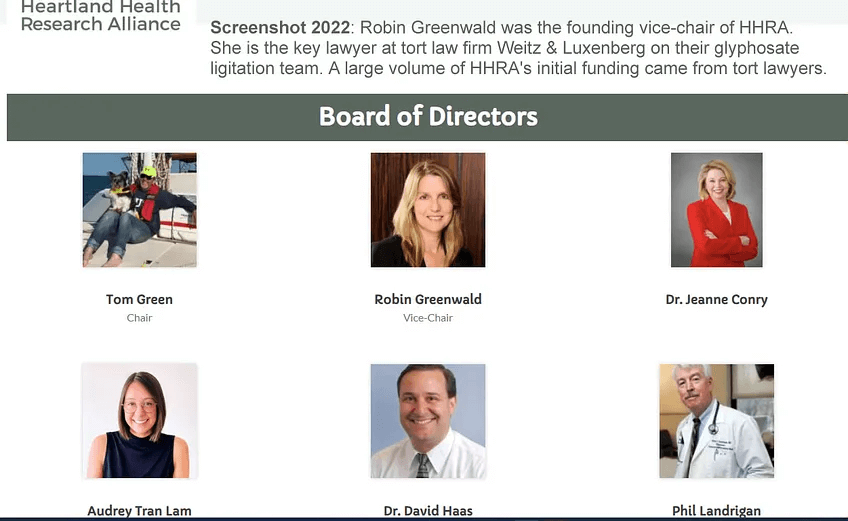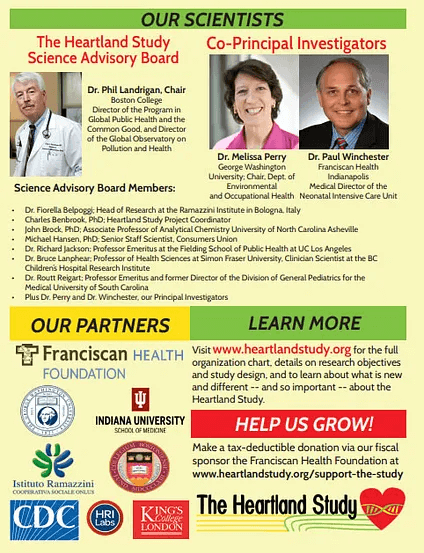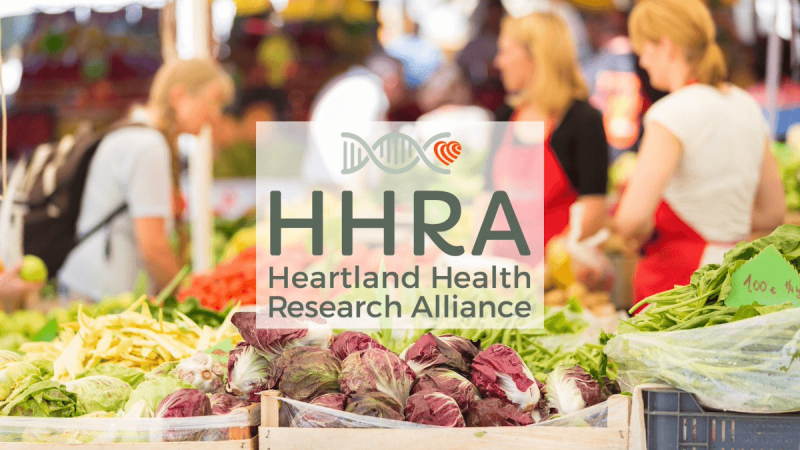Where would science be if the researchers at this institute conceive of and design a study on the basis of drawing conclusions to support their politically-driven objectives?
Where would science be if this study is funded via a large organic food company, tort law firms and non-transparent, donor-advised (dark) funding?
Where would science be today if this organization touts scientists who have been charged with research integrity issues?
If this were acceptable, then science would be at the heart of the Heartland Health Research Alliance and their Heartland Study.
The Heartland Health Research Alliance (HHRA) came into existence in 2020 following initial funding from Organic Valley, a leading organic cooperative with more than $1 billion in annual sales. Organic Valley has financed many anti-pesticide studies and campaigns led by the Heartland founder, Charles Benbrook. At that same time, US tort law firms were investing heavily in lawsuits against Monsanto on glyphosate so HHRA was able to easily attract funding from glyphosate litigators like BaumHedlund (now Wisner Baum), with a leading glyphosate lawyer heading the HHRA board of directors (Weitz & Luxenberg’s Robin Greenwald). All of this was orchestrated by the disgraced litigation consultant and organic food industry advocate, Charles Benbrook, who provided the HHRA with scientific leadership and his network of interested actors.
The objective behind creating HHRA was for it to run the Heartland Study (which was already raising funds from organic and litigator special interests prior to the HHRA formation). The Heartland Study has been designed to associate reproductive issues, birth defects and distressed pregnancies with exposure to herbicides. Assuming these conclusions could be correlated with herbicide traces in hospital urine samples, the organic food industry lobby could create further fear and outrage about herbicide use and tort law firms could sue more pesticide manufacturers for any complications during or after childbirth.
When public-funding opportunities for the Heartland Study started becoming more lucrative, the group quickly erased any links with tort law firms and removed references to the wily maverick, Benbrook and his family members staffing these efforts.

The Heartland Health Research Alliance exists, simply, to undermine trust in research, challenge the regulatory system, provide opportunities for law firms and interest groups to enrich themselves while creating fear and outrage within the population against industry and agriculture. The Heartland Study was designed not for discovery or for the benefit of society, but for these Heartland objectives. But greed and deception is not enough to succeed. In committing many foolish transgressions, we find an organization in chaos, lacking integrity and respect.
Trouble in the Heartland
Everything about the Heartland Health Research Alliance was sketchy from Day 1, from how Benbrook had assured people in the organic food industry he could “ramrod” a study through in record time (if fully funded) to how they have been sending interest group financiers for the Heartland Study through a donor-advised (dark money) foundation fronted by Franciscan nuns. The recent purification of their website from any traces of scientific impropriety or special interest funding meant a new group was taking over. HHRA was fast becoming Ramazzini West.

The Ramazzini Institute is a noted partner of the Heartland Study and a research group tied to the Collegium Ramazzini, a members-only club of mostly American occupational health activist scientists who meet once a year in Italy to network and exchange projects and opportunities. Their members have taken very strong political positions, mostly against industry and regulatory science, work regularly as litigation consultants and paid expert witnesses with US tort law firms and use their network to manipulate research findings in their own studies and in the International Agency for Research on Cancer (IARC) monographs (particularly on glyphosate, benzene, aspartame and talc).
Ramazzini fellows on the Heartland boards include the director, Fiorella Belpoggi, Melissa Perry and Philip Landrigan. This network was already sharing funding for different research projects and blurring the lines between research endeavours. As the Ramazzini Global Glyphosate Study had been struggling for funding for years, Philip Landrigan, involved in both this and the Heartland Study, found a way to transfer almost one million dollars from the Heartland Study budget to Ramazzini’s Global Glyphosate Study. This decision was taken by Landrigan and Perry in 2018 but only publicly announced in 2023.

The Ramazzini influence leaves behind a completely different stench within the Heartland than the tort lawyers and organic food industry lobbyists. Melissa Perry left her lab and academic position at the prestigious George Washington University after certain research integrity issues emerged from her publications. The Ramazzini studies on glyphosate and aspartame have been rejected by the mainstream scientific establishment (although interest groups like NGOs, food lobbies and tort law firms have continued to amplify them). It sets the narrative for how the Heartland Study will likely develop, publish, and amplify their findings.
The Heartland Study
The Heartland Study purports to ‘answer critical questions about the potential impacts of herbicides on mother and infant health, including whether there is a connection between herbicide exposure and birth defects or developmental challenges.’ The study lists childhood health problems such as autism, ADHD, asthma, obesity and leukemia as having been directly linked to the use of herbicides and exposure to ‘toxic chemicals.’
Claiming that the American Heartland (a.k.a. the Midwest) is the epicenter of rising herbicide use in the US, the study aims to enroll 2,000 mother-infant pairs and track their exposure to herbicides and insecticides by taking frequent urine samples, as well as documenting mother and child health over time (throughout pregnancy and at least until age 3 or possibly until children reach the age of 16). Cheek tissue samples are also to be taken, to look for epigenetic changes that would reflect the risk of premature birth or chronic diseases in later life.
Unfortunately, the study is under the control of the HHRA staff, rather than an unbiased research group or double blinded third party as would be expected for a standard clinical trial. What actually comprises the control group to compare test results with is also a mystery. How can one gauge increases in premature birth in the Heartland, if we have nothing to compare the numbers to?
The design of this study seems to be precisely set up to facilitate foul play of some format, whether this is fudging the data or cherry-picking subsets to manufacture a desired result for the Heartland’s interest groups (eg, tort law firms suing pesticide companies or the organic food industry).
Transparency (on a need-to-know basis)
As part of efforts to receive U.S. taxpayer funding for their efforts, Heartland recently claimed they have been awarded the Candid Platinum Seal of Transparency for 2023. This claim was made during the year where HHRA cleansed their website of any information of their funding, former board and staff members with conflicts of interests and any connection with special interest groups that would benefit from their conclusion-directed study. See the HHRA page on the Candid site (which remarkably has a lot of blank sections).
This transparency award claim is absurd. HHRA’s funding is completely dark. Earlier publications had shown how funding had come from interest groups who would benefit from their results (like the organic food industry lobby and tort law firms). Now nothing is published on their funding. The move to direct HHRA financing to donor-advised (dark money) funds like the Franciscan Health Foundation means no one knows who is actually funding the study. This apparently does not trouble the Heartland Study scientific advisory board as some members have a history of not disclosing their conflicts of interest.
There is also a rather cavalier use of Heartland funds quietly redirected for other purposes. Transferring almost a million dollars of Heartland Study funding to the Ramazzini Institute and then disclosing it only five years later (when the organization realized they needed to clean their act up if they would ever get government funding) speaks volumes of how little the Heartland scientists can be trusted. Transparency and conformity take a backseat to their special interests and opportunity.
Conclusion
What we have with this Heartland circus is a group of activist scientists working with interest groups (the organic industry and tort law firms) to non-transparently manufacture evidence that can be used to create fear, outrage, lawsuits and sidestep regulatory science. It reveals a network of sociopathic true believers, opportunists and zealots who have no qualms about misrepresenting data, raising unnecessary fears and over-playing emotional issues. They are doing this to advance their interests, get rich and destroy those they despise by orchestrating an illusion of research to undermine public trust in technologies and regulators.
Heartland represents the demise of evidence-based research showing how greed, deception and avarice can win over facts, innovation and entrepreneurship.
Kathleen L. Hefferon is an instructor in microbiology at Cornell University. Find her on X @KHefferon
David Zaruk is the Firebreak editor, and also writes under the pen-name The Risk Monger. David is a retired professor, environmental-health risk analyst, science communicator, promoter of evidence-based policy and philosophical theorist on activists and the media. Find David on X @Zaruk
A version of this article was originally posted at the Firebreak and is reposted here with permission. Any reposting should credit both the GLP and original article. Find the Firebreak on X @the_firebreak































